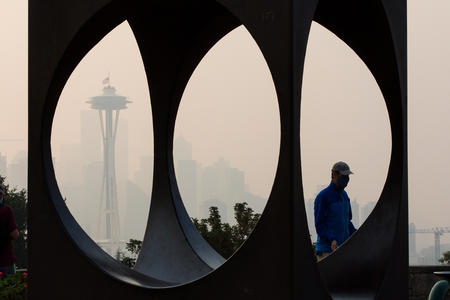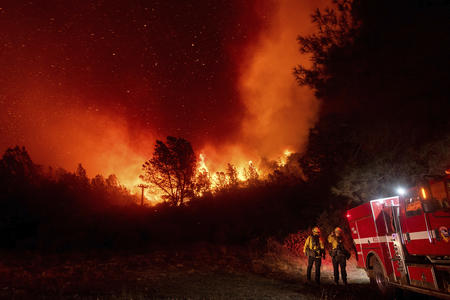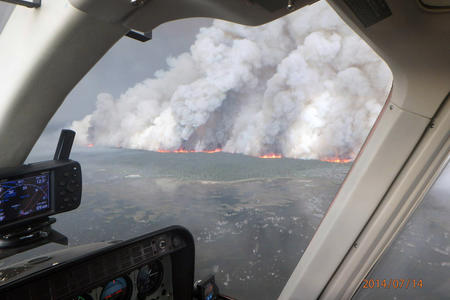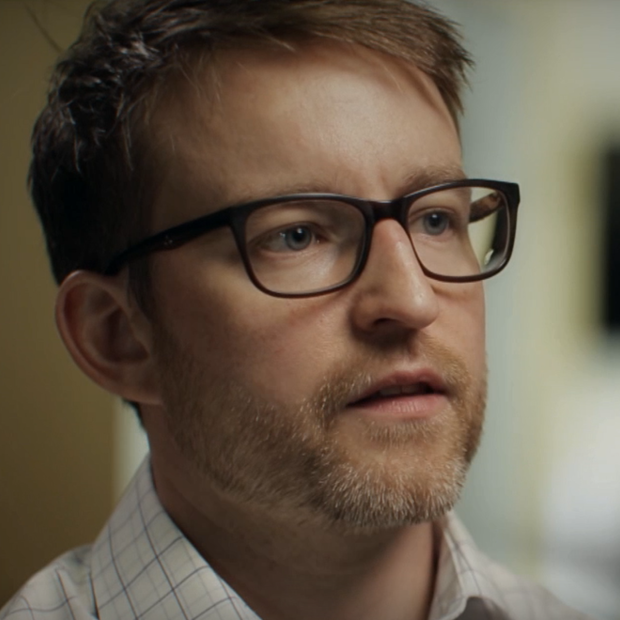Reese Lolley, whose employer, The Nature Conservancy, owned the parcel next to Martin’s property, was not proposing the awesome, awful sort of fire sweeping over 36,000 acres on and around Jolly Mountain and threatening to torch Roslyn in the summer of 2017.
Lolley’s fire would be small. It would creep across the dry brush and downed branches packing the understory of Martin’s woods on a ridge above Roslyn, the 959-person town just over the Cascade crest from Seattle that’s best known for standing in for a fictional Alaskan town in the 1990s hit television show Northern Exposure.
Fire — gentle, controlled fire — is exactly what experts say is needed to address the huge wildfires tearing through parched forests east of the Cascade crest. Filled with dead wood and brush, many forests are growing more combustible by the year because of climate change and a century of misguided fire suppression. Those conditions now put communities at risk of annihilation by fire. This year saw half a dozen towns destroyed in Washington, Oregon and northern California.
Ask us questions about your health and wildfire smoke at the bottom of this story, or click here.
In Washington, about 951,000 homes sit near forests threatened by wildfire. The most endangered communities lie in a swath extending from Spokane southwest to the Columbia River, and then running north past Wenatchee into the Methow Valley. Much of Central and Eastern Washington, in other words.
The state says the number of threatened homes is only set to grow.
Intentional burning of underbrush and dead trees — “prescribed fire” to those who practice it — is increasingly regarded as the key tool in making combustible forests fire-resistant and heading off “megafires.” But the technique is rarely used in the West, and prescribed fire rates actually decreased in the Northwest over the past two decades, one study showed.
InvestigateWest is a Seattle-based nonprofit newsroom producing journalism for the common good. Learn more and sign up to receive alerts about future stories here.
Bucking the trend, Martin said yes to Lolley and, as the Jolly Mountain fire smoldered, foresters burned 12 acres of his land. In the years since, Martin has increased that amount ninefold and prompted the city of Roslyn to use fire to clear the underbrush in its municipal forest.
“Honestly, that Jolly Mountain fire, to use a technical phrase, it was a change of underwear moment here in Roslyn,” said Martin, who serves as Roslyn’s emergency management coordinator. “I think our community had not really thought about fire. … It was a big wake up call.”
Planned burning drops as wildfires rage
Aggressive firefighting has left forests across the western United States primed for “megafires” like those that devoured 1,600 square miles of Washington timberland in 2015, leaving an ashy gray moonscape. Prescribed fire starves those apocalyptic burns while returning combustion to a biome built for it.
Following the U.S. Forest Service’s lead, land managers spent most of the 20th century extinguishing as many wildfires as they could, as fast as they could. On the dry slopes east of the Cascades, brush, branches and snags that would’ve burned then are burning now in forests packed too tightly for trees to stay healthy.
Dry forests like those surrounding Rosyln used to be seared every five to 10 years. Low-intensity fires, those that don't reach the crowns of trees, found ample tinder in the underbrush, saplings and fallen trees littering the forest floor. An ecosystem grew up around fires set by lightning and Native people, who used fire to cultivate staples like camas and to clear hunting ground for elk and deer.
Bold plans put forward by state leaders in late 2017 call for the intervention in 1,950 square miles of Washington forest. Prescribed fires would be set on hundreds of thousands of acres annually. The state government’s leading evangelist for prescribed fire, Public Lands Commissioner Hilary Franz, has been pushing state lawmakers for years to create a dedicated tax to fund the plan.
But Washington, like the rest of the West, has been slow to invest in prescribed burning. Trained fire workers are in short supply in the region, which has seen the acreage intentionally burned shrink even as a consensus for prescribed fire has formed. Ardent proponents note that, while burning could immediately protect towns and homes, decades will pass before prescribed fire has a meaningful impact on the growth of large fires. Returning to something approximating a natural “fire cycle” where less destructive blazes prune fire-prone forests would be the work of generations.
Prescribed fires burn low to the ground, removing combustible debris. It is a matter of physics. If flames can be kept short enough, fire on the forest floor doesn’t climb the branches to the top of the trees and destroy them. Thinning treatments, which see people cut down, carry away or chop up detritus to clear the forest floor, have a similar impact at a significantly higher cost.
Whether that current political will and shift in public sentiment will succeed in returning fire to the forest, though, remains an open question.
Support for prescribed fire is climbing, but the actual practice is not, said Crystal Kolden, an assistant professor at University of California, Merced, specializing in fire science. Reviewing fire records for a study published in April 2019, Kolden found the use of prescribed burning in the West hadn’t increased from 1998 to 2018 and actually fell in Washington and Oregon.
Trends aside, the total number of “treated” acres remains tiny compared with the apparent need and proffered goals. According to the National Interagency Coordination Center, the federal government’s fire hub, only 191 square miles in Washington and Oregon were treated with prescribed fire in 2019. While state-specific tallies were not available, experts agreed most of that fire burned in Oregon, where the state leaders recently relaxed restrictions on smoke created by prescribed fires.
“When we’re talking about the forest that needs treatment and the amount of forest that we’ve treated, there’s an order of magnitude difference between those numbers,” Kolden said. Land managers, she continued, are “struggling to keep up, and every year they fall farther behind.”
At present, Washington lacks the capacity to return fire to the forest in force.
The state, like its West Coast neighbors, is short on trained fire “practitioners” and burdened with regulations formed decades ago, when forest management almost always meant fire suppression. Regulators can deny a burn permit even after the crew has gathered on a remote site, making prescribed burns a chancy, expensive proposition.
Extreme fire seasons becoming the norm
Climate change is expected to intensify the frequency and severity of megafires across the United States, particularly in the dry western interior. Widely relied upon estimates predict the average summer will resemble extreme fire seasons like 2015, 2017 and 2020, when Seattle’s smoke-soaked air was at least briefly among the worst on the planet. By the 2080s, the acreage of Washington forest burned annually is expected to quadruple from the 20th century average, as temperatures rise and snowpack shrinks.
The climatic shift will find Washington’s forests filled with debris left to pile up during a century that saw naturally occurring fire heavily suppressed on most lands. With fire gone, a “fire deficit” deepens each year in the dry pine woods east of the Cascades.
In a recent study, Nature Conservancy researchers found that in Washington and Oregon just one-tenth of the forestland that should see fire each year does. Forest Service researchers estimate that the debt in unburned acres grows 140 square miles annually in the Okanogan-Wenatchee National Forest, which blankets 2,711 square miles on the eastern slopes of the Cascades. At current restoration rates, it would take 53 years to revive Washington’s federal lands, which comprise about 44% of Washington forestland.
“We’re trying to fix issues that took 100 years to get there,” said Steve Hawkins, a fuel program manager now in his 40th fire season with the Forest Service. “It’s going to take a while to get that rectified.”
Prescribed burning, coupled with thinning, creates conditions that can better accept fire, which is inevitable, said Paul Hessburg, a research landscape ecologist with the Forest Service’s Pacific Northwest Research Station.
For five years, Hessburg has been traveling the Northwest giving talks on wildfire science. He describes the effort as an experiment, a successful one, to determine whether a better understanding might encourage people to address the problem.
Hessburg’s takeaway was that public perceptions around fire are changing for the better “but tragically not fast enough” to get ahead of the changing climate. His hope is that targeted interventions may prevent the worst outcomes.
As Hessburg explains it, the question isn’t, “Can we regulate the size of the fires?” Any influence will be modest — the climate and weather mostly determine how much land is burned.
“The question is,” he said, “ ‘Can we moderate the … severity so that we can maintain more forest or habitats for the future?’ I think the answer is pretty solid that we can.”
Washington beginning to burn
Washington’s advocates for prescribed fire see the megafires that swept Washington in 2014 and 2015 as catalysts for the shift in public opinion they hope will enable them to do their work. Taken together, the fires burned 2,330 square miles of forest and rangeland and, along with fires in British Columbia, blanketed the Puget Sound in smoke for weeks. The cost in firefighting expenses alone topped $527 million.
The fires drew a vigorous, if standard, response from policy makers and shapers in the state. Committees coalesced, studies aimed at driving future legislation and funding launched. “Burner” training and community engagement initiatives were created or expanded.
And, in a limited way, prescribed fires started being set.
Kara Karboski caught what she calls the “fire bug” setting fires for the Defense Department at Joint Base Lewis-McChord. Karboski, now a coordinator with the Washington Resource Conservation & Development Council and a leading booster for prescribed fire, learned how burners go about their work while clearing brush on the military installation’s ample open spaces.
Before a fire, burners draw up a prescription — a set of judgments on what weather and forest moistness is required for the burn to be safe and effective, as well as a staffing and equipment list and detailed emergency plans. Hose lines are set and test fires lit before a crew of 10 or 20 workers set the fire in earnest.
“I've seen burns called off because it's just not burning well enough, maybe there's too much moisture,” Karboski said. “I’ve also been there where fire behavior has been too high, too much, too hot, and they've said, 'Wow, this is too much for us to handle.’ ”
Weather conditions are assessed to attempt to ensure the fire’s smoke clears. Practitioners point out that prescribed fires rarely smolder for weeks or months like wildfires, and that the smoke is lighter and less hazardous. Research has shown prescribed fire also helps tamp down climate change. That’s because thinned forests with fewer, larger trees sequester more carbon dioxide, and are less likely to burn to ash if a wildfire reaches them, releasing all that CO2.
On the prescribed fire line, workers “building black” with drip torches char a box of burned ground around the area slated for fire, Karboski said. Once the fire is set inside, they keep watch for any embers that cross that line.
Afterward, “it's not like it's a blackened wasteland,” she said. “The intention is to leave most of the trees still standing, so those are still there. And you'll have spaces where the fire can get into, so you get more of a mosaic.”
To Karboski’s eye, prescribed burns in Washington have been kept too small.
“Hundred-acre burns,” she said, “aren’t really getting us where you want to be.”
Smoke regulations barriers to controlled burning
One of the few tangible actions taken following the 2015 firestorm, the worst fire year in state history, was a $1.7 million pilot project meant to assess Washington’s ability to use prescribed fire.
While proponents describe the project as a learning exercise crucial to expanding the use of fire in Washington, those lessons were hard won.
In fall 2016 and spring 2017, fires were planned for 15 sites, 13 of which were in national forests. Tellingly, no privately held lands could be found to include in the pilot; private landowners have been put off prescribed fire by the bureaucratic hurdles, cost and liability concerns. Bringing fire to private lands is seen as a significant challenge to reviving Washington’s forests.
Although land managers selected the easiest spots, just one-third of the 13 square miles slated to burn during the project actually saw fire. One that did demonstrated a key argument against prescribed fire — smoke.
For a week in the fall of 2016, smoke from prescribed fires hung in the semiarid, V-shaped valleys north of Leavenworth, a faux Bavarian tourist town west of Wenatchee that has moved into the forest, where glassy, loudly rectangular second homes increasingly share sight lines with the squat chalets built a generation before. Air quality fell to levels hazardous to people who are particularly susceptible to smoke.
Controlling smoke rivals containing the fire itself for the top spot on the to-do list of any prescribed fire manger, known as the “burn boss.” Washington law requires that a state meteorologist sign off on any burn the morning it is set to begin; crews gathered for the burns are sent home if that permission doesn’t arrive.
The aging regulatory scheme governing smoke was drawn up at a time when industrial forestry filled Western Washington with smoke. The Department of Natural Resources, the Department of Ecology and the federal Environmental Protection Agency have been working on more permissive framework for years, but it is unlikely to receive a federal review until 2022 at the earliest.
Drawn up in the 1970s to satisfy requirements of the Clean Air Act, the smoke regulations last revised in the 1990s did not weigh the benefits of prescribed fire against its costs, said Lolley of The Nature Conservancy.
“It really was focused on the reduction in emissions, but didn't really consider forest health,” Lolley said.
Washington smoke regulations limit even the Forest Service’s prescribed burning. Though Oregon’s forests draw federal attention because they are more primed for intense, destructive fire, it’s also simply easier to burn in Oregon.
In the final report drawn from the pilot project, Department of Natural Resources researchers concluded that the regulatory framework keeps prescribed fires small and expensive by making larger burns impractical. It’s a view shared by Karboski.
“The system itself,” she said, “is set up to disincentive using fire.”
Incremental progress as concerns mount
Karboski’s tempered frustration, one shared by many concerned for the forests and their neighbors, stems in part from fear.
While the intersection of urban areas and wild lands has long been a concern for those who worry about fire full-time, the 2018 fire that destroyed Paradise, California, a town of 26,200 before it burned, laid bare the danger. Embers thrown miles by an intense fire in the neighboring forest set the town ablaze.
That the same could happen to Leavenworth, Roslyn or a host of other Washington mountain towns is beyond question. In Washington, homes and wildlands mix in over 4,500 square miles, an area almost the size of Connecticut. Millions of acres of privately held timberland could be converted into subdivisions.
In Olympia, state land managers are drawing up watershed-centered plans to prioritize forest restoration in areas where fire is most likely, and most likely to be destructive. The idea is to shape the landscape and secure better options for firefighters when fire does break out.
State Forester George Geissler of the Department of Natural Resources describes the forthcoming plans as a granular examination of each watershed, looking at land ownership to find areas where intervention would be most successful.
The Forest Service, too, is considering a new targeted approach to prescribed fire. Prescribed burning would be used to create spaces that would slow large wildfires, increasing the likelihood that some could be allowed to burn while providing firefighters a safer space to work from when they intervene.
In an interview, Geissler ticked through the efforts underway. Assistance programs for landowners. Training initiatives to build a workforce. Changes in law to reduce restrictions on prescribed fire. The dialogue with the EPA to revise the smoke rules. His own appointment; Geissler, who had been serving as Oklahoma’s state forester, said he was hired two years ago specifically for his background in burning.
“With each incremental change, we are making the opportunity to utilize prescribed fire greater,” Geissler said.
Acknowledging that prescribed fire has been underused in Washington, Geissler cautioned that it is “not a magic Band-Aid” that can immediately fix what generations of fire suppression broke. He said he believes the public supports the work, and hopes Washingtonians — including those in the Legislature — will stay engaged.
“We live in a society that if you can't get [something] done in two years, you probably failed at it, and yet in forestry I was taught that 30 years is a short time,” Geissler said.
The Nature Conservancy’s Lolley offered a similar view.
“We're moving in the right direction,” said Lolley, whose organization has been instrumental in training fire practitioners and bringing fire to privately owned lands. “And I think we are getting smarter about how to prioritize the investments of money … to have bigger gains.”
But, he allowed, “at our current rate of treatment, it will make a difference, but it’s not near what we need.”
The costs are substantial, and the benefits distant.
Advances in plywood manufacturing and heaters that burn pelletized scrap wood could conceivably make thinning profitable in some forests, but the forest restoration won’t pay for itself. And while proponents contend restoration will save millions over the long run, firefighting costs will continue to rise even as the restoration work takes shape.
Behind the curve
Fire gently burns in the hills above Rosyln again, this time on the city-owned land bordering Martin’s property. The fire makes the town an exception, frustratingly so in Martin’s view.
Martin enthuses about fire’s effect on his forest, which he bought to visit and protect from development. Since the fire, elk have returned to the newly open forest, as have turkey and bear. He’s proud that it may protect Roslyn the next time fire rises in the forests that surround it.
And yet he stops short of encouraging others to burn. The “bureaucratic roadblocks,” he said, are still too large for landowners without an abundance of money and energy to overcome.
“In Washington state, we are far behind the curve on this stuff,” Martin said.







